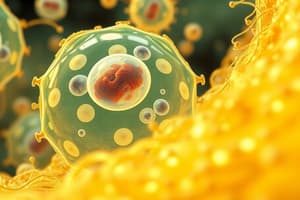Podcast
Questions and Answers
What is one of the primary functions of the cell membrane?
What is one of the primary functions of the cell membrane?
- To regulate the movement of substances (correct)
- To produce energy for the cell
- To synthesize proteins
- To store genetic material
How does the cell membrane contribute to cellular communication?
How does the cell membrane contribute to cellular communication?
- By receiving and sending out stimuli (correct)
- By facilitating cellular respiration
- By generating heat for the cell
- By providing attachment for the cytoskeleton
Which of the following is NOT a function of the cell membrane?
Which of the following is NOT a function of the cell membrane?
- Allows for cell-to-cell recognition
- Protects the cell
- Forms specialized junctions with adjacent cells
- Synthesizes proteins (correct)
What role does the cell membrane play in substance transport?
What role does the cell membrane play in substance transport?
In addition to protection, which function associated with the cytoskeleton is performed by the cell membrane?
In addition to protection, which function associated with the cytoskeleton is performed by the cell membrane?
What primarily influences the size and shape of cells in the human body?
What primarily influences the size and shape of cells in the human body?
Which component is NOT part of the common basic structure shared by human cells?
Which component is NOT part of the common basic structure shared by human cells?
What encloses the nucleus in human cells?
What encloses the nucleus in human cells?
Human cells exhibit variations. Which statement about these variations is accurate?
Human cells exhibit variations. Which statement about these variations is accurate?
Which of the following statements is true regarding human cells?
Which of the following statements is true regarding human cells?
Flashcards are hidden until you start studying
Study Notes
Cell Structure and Variation
- Human cells exhibit a wide range of size, shape, and form, which varies across different cell types and even within the same type.
- Variations in cell morphology are primarily influenced by the specific functions and activity levels of the cells.
- Despite diversity, all human cells share a common basic structure typical of eukaryotic cells.
Components of a Cell
- Cells consist of cytoplasm encased by a cell membrane, with a nucleus embedded in the cytoplasm.
- The nucleus is surrounded by a nuclear envelope, providing a defined area for genetic material.
Functions of the Cell Membrane
- Protection: The cell membrane acts as a barrier, safeguarding internal cellular components.
- Selective Permeability: Regulates the movement of substances in and out of the cell, maintaining homeostasis.
- Transport Regulation: Controls the entry and exit of ions, nutrients, and waste products.
- Cytoskeleton Attachment: Provides a site for the attachment of the cytoskeleton, influencing cell shape and stability.
- Signal Reception: Receives stimuli from external environment, facilitating communication and response.
- Receptor Sites: Contains binding sites for enzymes and various substances, playing a key role in cellular signaling.
- Cell Recognition: Enables cell-to-cell recognition essential for tissue formation and immune response.
- Specialized Junctions: Forms junctions with adjacent cells and the extracellular matrix, contributing to tissue structure and function.
Studying That Suits You
Use AI to generate personalized quizzes and flashcards to suit your learning preferences.



